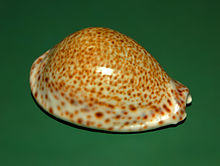- Erosaria turdus
-
Erosaria turdus A shell of Erosaria turdus, anterior end towards the right Scientific classification Kingdom: Animalia Phylum: Mollusca Class: Gastropoda (unranked): clade Caenogastropoda
clade Hypsogastropoda
clade LittorinimorphaSuperfamily: Cypraeoidea Family: Cypraeidae Subfamily: Erosariinae Genus: Erosaria Species: E. turdus Binomial name Erosaria turdus
(Lamarck, 1810)Synonyms[1][2] - Cypraea turdus Lamarck, 1810 (basionym)
- Cypraea ovata Perry, G., 1811
- Cypraea arenosa Dillwyn, L.W., 1823
- Cypraea alba Sowerby, G.B. I, 1832
- Monetaria hamyi Rochebrune, A.-T. de, 1884
- Erosaria raripuncta Sulliotti, G.R., 1911
- Cypraea zanzibarica Sulliotti, G.R., 1911
- Cypraea phyllidis Shaw, H.O.N., 1915
- Erosaria miyokoae Habe, T. & S. Kosuge, 1970
Erosaria turdus , common name : the thrush cowrie, is a species of sea snail, a cowry, a marine gastropod mollusk in the family Cypraeidae, the cowries.[1]
Contents
Subspecies
- Erosaria turdus dilatata (Dunker, R.W., 1852) [3]
- Erosaria turdus distinguenda (Lamarck, J.B.P.A. de, 1810) [4]
- Erosaria turdus micheloi Chiapponi, 2009 [5]
- Erosaria turdus pardalina (Dunker, R.W., 1852) [6]
- Erosaria turdus turdus (Lamarck)
- Erosaria turdus winkworthi Schilder, F.A. & M. Schilder, 1938 [7]
Description
The shells of these uncommon cowries reach on average 30–38 millimetres (1.2–1.5 in) of length, with a minimum size of 16 millimetres (0.63 in) and a maximum size of 62 millimetres (2.4 in). They are quite variable in pattern and color. The shape is more or less oval, the dorsum surface is smooth and shiny, the basic color is whitish, yellowish or greenish, with small brown spots all over, becoming larger on the sides. The interior of the shell, visible through the aperture, may be light purple. The subspecies Erosaria turdus dilatata usually bears a large irregular patch on the dorsum. The margins are white, with several brown dots and a pronounced labial 'callus'. The base is white or pale pink, sometimes with a small brown mark in the middle. The long and wide aperture shows about 15 teeth on the columellar and labial teeth. The shells of Erosaria turdus are externally quite similar to Erosaria lamarckii. In the living cowries the mantle is yellowish or beige, with long tree-shaped brown papillae.
A shell of Erosaria turdus, dorsal view, anterior end towards the right A shell of Erosaria turdus, lateral view, anterior end towards the right
A shell of Erosaria turdus, lateral view, anterior end towards the right A shell of Erosaria turdus, ventral view, anterior end towards the left
A shell of Erosaria turdus, ventral view, anterior end towards the left
Distribution
This species is distributed in the Red Sea, in the Gulf of Oman and in the North West of the Indian Ocean, along Pakistan, India, in the East Africa (Comores, Eritrea, Kenya, Madagascar, Mozambique, Oman, Somalia, Tanzania), in the East Coast of South Africa and - as a non-indigenous species - in European waters and in the Mediterranean Sea (Lampedusa, Israel, Djerba Island in Tunisia, Libya, Egypt), where it has been introduced through the Suez Canal.
Habitat
These cowries live in intertidal shallow waters at 2–10 metres (6 ft 7 in–32 ft 10 in) of depth. In the Indian Ocean they prefer the coral reef, while in the Mediterranean Sea they can be found on algal turf or sandy and muddy sea bed.
References
- ^ a b Erosaria turdus (Lamarck, 1810). Gofas, S. (2009). Erosaria turdus (Lamarck, 1810). In: Bouchet, P.; Gofas, S.; Rosenberg, G. World Marine Mollusca database. Accessed through the World Register of Marine Species at http://www.marinespecies.org/aphia.php?p=taxdetails&id=139498 on 24 October 2010.
- ^ Gastropods.com : Erosaria turdus; accessed : 24 October 2010
- ^ Gastropods.com : Erosaria turdus dilatata; accessed : 24 October 2010
- ^ Gastropods.com : Erosaria turdus distinguenda; accessed : 24 October 2010
- ^ Gastropods.com : Erosaria turdus micheloi ; accessed : 24 October 2010
- ^ Gastropods.com : Erosaria turdus pardalina; accessed : 24 October 2010
- ^ Gastropods.com : Erosaria turdus winkworthi; accessed : 24 October 2010
- Verdcourt, B. (1954). The cowries of the East African Coast (Kenya, Tanganyika, Zanzibar and Pemba). Journal of the East Africa Natural History Society 22(4) 96: 129-144, 17 pls
- Streftaris, N.; Zenetos, A.; Papathanassiou, E. (2005). Globalisation in marine ecosystems: the story of non-indigenous marine species across European seas. Oceanogr. Mar. Biol. Ann. Rev. 43: 419-453
External links
This Cypraeidae-related article is a stub. You can help Wikipedia by expanding it.




